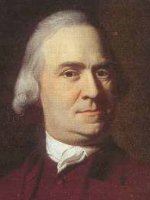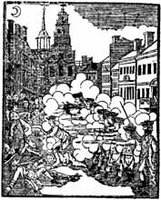 A Travel Guide to Colonial Boston, published by the Lucent Books imprint of the Thomson-Gale Company, is ridiculously full of errors. It’s shot through worse than a British officer walking slowly up Bunker Hill. A few quotations will show what I mean.
A Travel Guide to Colonial Boston, published by the Lucent Books imprint of the Thomson-Gale Company, is ridiculously full of errors. It’s shot through worse than a British officer walking slowly up Bunker Hill. A few quotations will show what I mean.
In 1774 representatives of all colonies hurried to Philadelphia to form the Continental Congress with the objective of declaring independence from England.
In fact, only twelve colonies participated in the First
Continental Congress in 1774. Georgia didn’t send a delegate. (Neither did Nova Scotia, which had had Stamp Act protests, or other British colonies in North America—but that’s another story, which we Americans don't dwell on.) Declaring independence was not the objective of that Congress, but a measure adopted after more than a year and a half of developments and debate.
John Adams, his cousin Samuel Adams, and Paul Revere represented Boston.
Boston did not send representatives; Massachusetts did. The province’s representatives were the Adams cousins plus Thomas Cushing and
Robert Treat Paine. In the later Congress that declared independence,
Elbridge Gerry replaced Cushing.
Paul Revere never represented his province, state, or town as a legislator. His only link to the First Continental Congress was that in Sept 1774 he carried messages to Philadelphia and back.
On April 18, 1775, to counter this act of rebellion, English general Thomas Gage ordered his troops to cross the Charles River, march the remainder of the twenty miles from Boston to the nearby towns of Concord and Lexington, and to destroy hidden caches of ammunition.
Gage wasn’t trying to stymie the Continental Congress in Philadelphia; he was responding to the Provincial Congress in Massachusetts. He didn’t order his troops to march to Lexington; that town was simply on the way to Concord. Concord’s center was seventeen miles from Boston, not twenty. (And for the copy editor, there must be either a “to” in front of “march” or no “to” in front of “destroy” to keep the items in that series parallel.)
Paul Revere and William Dawes, who got wind of the action, rode throughout the countryside urging the local militia—also known as minutemen because each was ready for war at a minute’s notice—to hurry to Concord and Lexington with loaded muskets.
Dawes didn’t speak to any local militia during his ride; he went straight to John Hancock and Samuel Adams in Lexington. Revere did spread the word to his militia contacts. But neither of them told officers to send their men “to Concord and Lexington” since they couldn’t say for sure where the British column was headed.
At the same time, Robert Newman climbed the steeple at the North Church and suspended two lanterns.
Newman hung the lanterns before Revere set out from Boston, not at the same time.
For all who knew this secret code, it warned that the English were advancing up the Charles River.
Very few people knew what the two lanterns meant; Revere had arranged that signal specifically for his contacts in Charlestown. The British troops (they weren’t just English) didn’t head up river but crossed the Charles and then marched away from it.
The minutemen drew the battleline at Concord Bridge. As General Gage and his troops approached the old bridge and ordered the minutemen to stand aside, the militia took aim at the English line of musketeers.
Gage wasn’t on this expedition himself. The North Bridge in Concord was only fifteen years old. Three companies of British regulars were holding that bridge when the militiamen marched down toward it, trying to cross back into town—not the other way around. And no one at the time referred to British soldiers as “musketeers.”
No one knows who fired first, but by the end of the day, 93 patriots lay dead or badly wounded. The English lost 272 men. The War of Independence was on.
Strong evidence says that at Concord some outnumbered British soldiers fired first on the advancing militia. The
Travel Guide author apparently confused that moment with what happened at Lexington, where no one knows who fired first. (In fact, the book never mentions the shooting at Lexington at all, though Americans at the time made more of it.) As for the numbers, the provincials suffered only 50 dead or dying of wounds, with 39 otherwise wounded and 5 missing. The number 272 is the total of British casualties, including 65 killed, 180 wounded, and 24 missing, so those “English”
lost only 89 men.
Raging against the audacious actions of the minutemen, Gage began a siege of Boston.
From inside the town? No, sieges begin from the outside. The provincial militia companies besieged Boston, trapping the British army.
Thousands of minutemen hurried to Boston and occupied Breed and Bunker Hills in Charles Town, immediately across the channel at the north end of the city.
Right after the Battle of Lexington and Concord, the British army encamped on Bunker Hill (the whole prominence was usually called by that name until the early 1800s, when historians started a spitting contest over the name “Breed’s Hill”—but that’s another story). Provincials didn’t try to occupy Charlestown for another two months, until June 16. Technically, Boston was still not a “city,” but a town.
On June 17, 1775, both armies began an artillery bombardment that killed 230 English and wounded 800. Minuteman losses were half what the English suffered.
This makes it sound like the Battle of Bunker Hill was entirely an exchange of artillery. The Americans’ cannons were close to negligible, and they inflicted most of the damage with muskets. The exact British casualty figures are documented: 226 dead, 828 wounded. The American figures are more approximate: about 150 dead and 300 wounded.
Badly mauled, Gage’s army broke off the battle and pulled back to the Boston Common where they stayed for the duration of the year.
Gage’s army won this battle, chased the provincials off the hill, and kept control of Bunker Hill and all of the Charlestown peninsula until March 1776, when Gage’s successor ordered his forces to evacuate.
All those errors appear in consecutive sentences on a single page. (Page 21, to be specific.) This
Travel Guide to Colonial Boston is in no way a reliable source of historical information for young readers. In an upcoming post I’ll return to this book and share more choice bits. Why? Because I'm feeling cranky? Because I like showing off? Because I have nothing else to put on this blog? No, no, it's [sanctimonious intonation] for the kids.
ADDENDUM: What should a kids' history book in the guise of a travel guide to Boston in 1793 look like? See
part 2.




